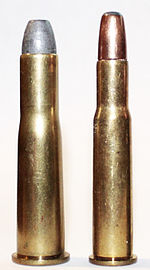.38-56 WCF
| .38-56 WCF | ||||||||||||
|---|---|---|---|---|---|---|---|---|---|---|---|---|

.38-56 WCF (left) and .30-30 Winchester (right)
|
||||||||||||
| Type | Rifle | |||||||||||
| Place of origin | United States | |||||||||||
| Specifications | ||||||||||||
| Case type | Rimmed, Bottleneck | |||||||||||
| Bullet diameter | .3775 in (9.59 mm) | |||||||||||
| Neck diameter | .40 in (10 mm) | |||||||||||
| Shoulder diameter | .445 in (11.3 mm) | |||||||||||
| Base diameter | .505 in (12.8 mm) | |||||||||||
| Rim diameter | .605 in (15.4 mm) | |||||||||||
| Rim thickness | .065 in (1.7 mm) | |||||||||||
| Case length | 2.10 in (53 mm) | |||||||||||
| Overall length | 2.50 in (64 mm) | |||||||||||
| Primer type | Large Rifle | |||||||||||
| Ballistic performance | ||||||||||||
|
||||||||||||
|
Test barrel length: 26" Source(s): LoadData.com, Rifle Magazine |
||||||||||||
The .38-56 Winchester Center Fire cartridge was introduced in 1887 by Winchester for the Winchester Model 1886, and was also used in the Marlin Model of 1895. Production of Model 1886s chambered in this cartridge ceased in 1910 due to lack of demand, while most commercial production of the cartridge itself ceased in the 1930s. New production loaded cartridges and unloaded brass cases are rare, and are often created using reformed .45-70 brass. The cartridge was originally intended to outperform the similar .38-55 Winchester, but in reality had very similar ballistics despite using more gunpowder.
...
Wikipedia
